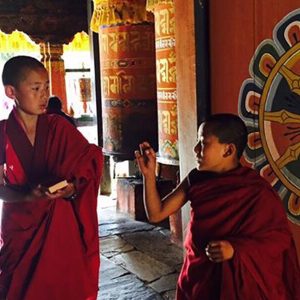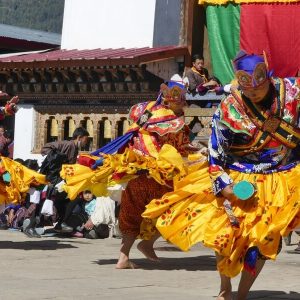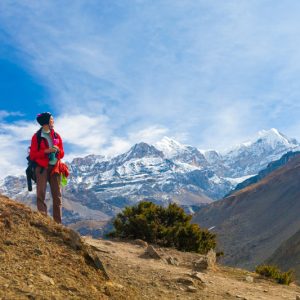Bhutan’s architecture is unlike any other in the Himalayas—spiritual yet practical, monumental yet always in harmony with nature. From fortress-monasteries (dzongs) and cliffside temples to humble farmhouses and sacred chortens, each structure is infused with symbolism and artistry, rooted in Vajrayana Buddhist beliefs and centuries of tradition.
In this article, Travel Across Bhutan takes you on a journey through the kingdom’s most remarkable architectural wonders. We’ll explore the history and symbolism behind Bhutanese design, the construction methods and materials that give these buildings their timeless strength, and the must-visit sites—from the grand Punakha Dzong to the cliffside Tiger’s Nest Monastery—that embody Bhutan’s unique cultural identity.
Whether you’re an architecture enthusiast, a history lover, or a traveler seeking deeper meaning in your journey, Bhutan’s built heritage offers an experience unlike anywhere else in the world.
The Historical Foundations of Bhutanese Architecture

Architecture in Bhutan has been shaped by Buddhism, geography, and history.
Its earliest examples date back to the 6th and 7th centuries, but the 17th century was pivotal: Shabdrung Ngawang Namgyal, also known as “the bearded lama” and unifier of Bhutan, commissioned the construction of dzongs across the country. These fortress-monasteries protected the land from Tibetan invasions and established a dual system of governance, where secular and monastic life coexisted under one roof.
Construction itself has long been seen as a sacred act in Bhutan. Before laying foundations, locals traditionally seek the blessing of local deities and spirits believed to inhabit the land. Even today, new homes and temples are inaugurated with pujas, dances, and rituals to protect the building and its inhabitants.
Building Materials and Traditional Craftsmanship

Bhutanese architecture blends seamlessly with its environment, using natural, locally sourced materials:
- Rammed earth and stone: Used for thick walls that gently taper upward, providing insulation and earthquake resilience.
- Timber: For floors, windows, beams, and roofs, joined using intricate carpentry without nails or metal fasteners.
- Bamboo: More common in southern Bhutan due to its abundance.
- Shingle and slate roofs: Layered, hovering gables that seem to “fly” above the buildings.
Carpenters (zow) and masons (dozop) were traditionally so skilled that they built entire complexes without written blueprints, relying on hand measurements and memory.
These methods were not only sustainable but also remarkably resilient against the Himalayan climate and seismic activity. Columns known as chum were placed close together so that if one failed, it would fall onto the next, preventing collapse. Stones were carefully interlocked, and wooden joints were designed to absorb movement during earthquakes. Sloping shingle roofs shed heavy monsoon rains, while thick rammed-earth walls provided insulation against both summer heat and winter cold.
Every detail of construction balanced aesthetic harmony, functionality, and durability—a philosophy that continues to shape Bhutan’s evolving architecture today.
Key Features of Bhutanese Architecture

Several distinct elements make Bhutanese architecture instantly recognizable:
- Thick whitewashed walls with red or golden stripes near the top.
- Tapering silhouettes, symbolizing stability and harmony.
- Multi-tiered wooden roofs with large overhangs to withstand monsoons.
- Elaborately carved wooden windows and balconies, often painted in vivid colors.
- Sacred symbols painted or carved on walls—lotus flowers, dharma wheels, protective deities, and sometimes phallic symbols for fertility and protection.
- Religious blessing rituals at the beginning and completion of construction.
- Standalone spirit houses (lu khang) within complexes to honor unseen beings.
- Decorative talismans, such as cloth squares inscribed with prayers, hung from rafters.
- Wooden cantilever or chain bridges connecting valleys, often centuries old.
Together, these elements embody Bhutan’s philosophy of architecture as both divine offering and communal identity.
Dzongs: The Fortresses of Faith and Authority

Dzongs are the crown jewels of Bhutanese architecture—massive fortress-monasteries that serve both spiritual and administrative purposes.
Built mainly in the 17th century, dzongs served as defensive strongholds and hubs of governance. Their dual-purpose design reflects Bhutan’s unique intertwining of religion and politics.
Their sheer scale, monumental walls, and commanding locations reflect Bhutan’s history of defense, governance, and religion woven together in a single structure. Each dzong is unique, but all share certain traits: whitewashed walls, inward-sloping sides, intricately carved wooden windows, and gilded rooftops. Inside, courtyards bustle with monks, officials, and festivals, making dzongs the beating heart of Bhutanese cultural life.
Architectural Features
- Massive rammed-earth or stone walls.
- Central towers (utse) surrounded by courtyards.
- White exteriors with red-and-gold bands and intricately carved roofs.
- Large courtyards that host festivals and gatherings.
Punakha Dzong (Pungtang Dechen Phodrang)
Often called the “Palace of Great Bliss,” Punakha Dzong is considered the most beautiful fortress in Bhutan. Strategically placed at the confluence of the Pho Chhu and Mo Chhu rivers, it has withstood floods, fires, and earthquakes since its construction in 1637. The dzong is famed for its towering whitewashed walls, richly decorated temples, and the sacred relics it houses, including the embalmed body of Zhabdrung Ngawang Namgyal, the founder of Bhutan. In spring, its courtyards are framed by blooming jacaranda trees, creating one of the country’s most photogenic scenes.
Trongsa Dzong
The largest dzong in Bhutan, Trongsa Dzong sprawls across a ridge above the Mangde Chhu River. Its labyrinth of temples, corridors, courtyards, and staircases reflects centuries of architectural evolution. Historically, it held enormous political importance—control of Trongsa was seen as the key to ruling Bhutan. Even today, Bhutanese kings are first appointed as the governor of Trongsa before ascending the throne, underlining the dzong’s enduring legacy.
Paro Dzong (Rinpung Dzong)
Translated as the “Fortress of the Heap of Jewels,” Paro Dzong dominates the Paro Valley with its commanding presence. Originally built in the 15th century and reconstructed in the 17th, it remains one of the best-preserved dzongs. Beyond its administrative and monastic functions, it is famous for hosting the Paro Tshechu, one of Bhutan’s most colorful festivals, where masked dances and spiritual rituals draw both locals and visitors. The dzong’s wooden cantilever bridge across the Paro Chhu is another architectural highlight.
Tashichho Dzong (Thimphu)
Serving as the seat of Bhutan’s government, Tashichho Dzong blends tradition with modern adaptation. Rebuilt in the 20th century to house ministries and the king’s offices, it also retains its monastic functions, with part of the complex dedicated to the central monk body. Its grand structure, surrounded by gardens and the Wang Chhu River, becomes especially striking at night when illuminated against the backdrop of the Thimphu hills.
Other Notable Dzongs in Bhutan
- Wangdue Phodrang Dzong – Recently reconstructed after a devastating fire, it commands views of central Bhutan’s valleys.
- Dagana Dzong – Known for its quiet majesty and proximity to remote communities, reflecting how dzongs extend governance into Bhutan’s farthest corners.
From the sacred relics of Punakha to the political symbolism of Trongsa, Bhutan’s dzongs are more than architectural feats—they are guardians of Bhutanese identity, housing the nation’s spiritual treasures and administrative authority under the same roof.
Temples and Lhakhangs: Sanctuaries of Devotion

Unlike the monumental dzongs or cliffside monasteries, Bhutan’s temples—known as lhakhangs—are usually modest in scale, blending seamlessly into villages, valleys, or hillsides.
Yet their size belies their importance: each lhakhang is a microcosm of Bhutanese spirituality, filled with symbolism, stories, and artistry. Their exteriors are typically simple—whitewashed walls capped with red ochre bands, small windows framed with wood carvings—while their interiors reveal another world entirely: gilded statues of deities, altars adorned with offerings, and vibrant frescoes depicting Buddhist cosmology.
For Bhutanese families, these temples are the heart of spiritual practice, hosting rituals, blessings, and festivals tied to the cycles of life.
Kyichu Lhakhang (Paro)
Often described as the “soul of Bhutan,” Kyichu Lhakhang is one of the country’s oldest and most revered temples. Built in the 7th century by Tibetan King Songtsen Gampo, it is said to be part of a network of 108 temples constructed in a single day to subdue a giant demoness who threatened the spread of Buddhism in the Himalayas. The temple’s serene gardens, prayer wheels, and ancient orange tree (which, legend says, bears fruit year-round) create an atmosphere of timeless peace. Pilgrims come here to circumambulate the temple and to meditate in its sacred halls, where centuries of devotion are palpable.
Jambay Lhakhang (Bumthang)
Another jewel of the 7th century, Jambay Lhakhang is equally tied to the great Songtsen Gampo’s temple network. Located in Bumthang, a region often considered the spiritual heart of Bhutan, this temple has long been a site of royal patronage and community festivals. Its most famous event is the Jambay Lhakhang Drup, a multi-day festival featuring sacred dances, including the rare naked fire dance performed at midnight to bless infertile women and drive away evil spirits. Architecturally, the temple combines simplicity with a sense of profound sanctity, making it a must-visit for those seeking Bhutan’s spiritual roots.
Chimi Lhakhang (Punakha)
Affectionately known as the Fertility Temple, Chimi Lhakhang is dedicated to the eccentric 15th-century saint Drukpa Kunley, also known as the “Divine Madman.” Unlike other lamas, Drukpa Kunley used humor, unorthodox methods, and sometimes shocking behavior to spread Buddhist teachings. Today, couples visit Chimi Lhakhang seeking blessings for fertility, and its walls are famously decorated with paintings of phalluses, symbols of protection and creativity in Bhutanese tradition. The short walk to the temple passes through beautiful rice fields, adding to its charm as both a spiritual and cultural experience.
Other Noteworthy Temples in Bhutan
- Tamzhing Lhakhang (Bumthang) – Built in the 16th century by the revered saint Pema Lingpa, this temple is rich in original murals and is still home to a monastic community.
- Changangkha Lhakhang (Thimphu) – A hilltop temple dating back to the 12th century, it is especially popular with parents who bring newborns here for blessings.
- Kurjey Lhakhang Complex (Bumthang) – Closely linked to Guru Padmasambhava, who left his body imprint on a rock here, this site is considered one of the holiest in Bhutan.
Together, Bhutan’s lhakhangs show that architectural beauty is not always in grandeur. Their quiet presence, spiritual depth, and intimate role in community life reveal another dimension of Bhutan’s architectural soul—one centered on faith, ritual, and the rhythms of daily devotion.
Monasteries: Where Spirituality Meets Landscape

Bhutan’s monasteries (lhakhangs) are not just places of worship; they are living symbols of the kingdom’s spiritual identity and its deep connection to the land. Built in dramatic locations—on cliffs, in valleys, or at the heart of villages—these monasteries embody Bhutan’s belief that sacred architecture should merge seamlessly with nature.
Paro Taktsang (Tiger’s Nest)
Arguably the most iconic site in Bhutan, the Tiger’s Nest Monastery clings to a sheer cliff 900 meters above the Paro Valley. Legend holds that Guru Padmasambhava, the founder of Vajrayana Buddhism in Bhutan, flew here on the back of a tigress to meditate in the 8th century. The complex grew around his meditation cave, creating one of the most awe-inspiring pilgrimage sites in the Himalayas. The monastery’s design—whitewashed walls, golden roofs, and wooden balconies—contrasts beautifully with the dark granite cliffs, while the steep trek to reach it adds to the spiritual experience. Inside, visitors encounter richly decorated shrines and flickering butter lamps, reminders of Bhutan’s enduring Buddhist traditions.
Gangtey Monastery (Gangtey Goenpa)
Perched on a ridge overlooking the glacial Phobjikha Valley, Gangtey Monastery is celebrated for its architectural grace and sweeping views. Built in the 17th century, it is one of the main centers of the Nyingma school of Buddhism in Bhutan. The monastery complex includes a central temple, monks’ quarters, meditation centers, and schools, making it both a spiritual and educational hub. Every November, the courtyard comes alive during the Black-Necked Crane Festival, which honors the endangered birds that migrate here each winter. The festival blends conservation awareness with cultural performances, reflecting Bhutan’s harmony between spirituality and nature.
Other Remarkable Monasteries in Bhutan
- Tango Monastery (near Thimphu) – A 13th-century site rebuilt in the 17th century, it serves as a leading Buddhist university where future spiritual leaders are trained.
- Cheri Monastery – Founded by Shabdrung Ngawang Namgyal in 1620, this monastery is revered as the place where Bhutan’s first monastic body was established.
- Kurjey Lhakhang (in Bumthang) – Built around another meditation cave of Guru Padmasambhava, it is considered one of the holiest sites in the country and a pilgrimage destination for Bhutanese kings.
From cliffside sanctuaries to valley retreats, Bhutan’s monasteries are as much about their locations as their architecture. Each one tells a story of faith, resilience, and harmony with the natural world, offering travelers unforgettable moments of beauty and reflection.
Chortens: Sacred Monuments of Memory

Chortens (stupas) dot the Bhutanese landscape, each a symbolic map of Buddhist cosmology:
- Base = Earth
- Dome = Water
- Spire = Fire
- Umbrella = Air
- Pinnacle = Space
Types of Chortens
- Nepalese-style: Large domes, carved ornamentation.
- Tibetan-style: Flared bases, wooden superstructures.
- Indigenous Bhutanese style: Square stone pillars topped with lunar and solar symbols.
Famous Chortens in Bhutan
- National Memorial Chorten (Thimphu): Built in memory of Bhutan’s third king.
- Dochula Pass Chortens: 108 white chortens built by the Queen Mother, set against Himalayan peaks.
- Kurjey Lhakhang Chortens (Bumthang): A wall of 108 chortens built to commemorate Guru Rinpoche.
Traditional Bhutanese Homes
Among Bhutan’s architectural treasures, the Bu house stands out as a timeless symbol of ingenuity and identity. Rising two to three stories high, these farmhouses were built without formal plans—crafted instead through skills passed down through generations.
Their multi-tiered façades, small arched windows, and sloping shingle roofs are instantly recognizable, but beyond their beauty lies a deeply functional design: livestock below, storage in the middle, and family life with a shrine above.
More than homes, Bu houses are cultural spaces. The largest room was always the kitchen, buzzing with activity and warmth, while the shrine room reflected the spiritual heartbeat of the household. Windows were placed low so even those seated on the floor could glimpse the outside world, a detail that reveals both practicality and thoughtfulness.
Regional Variations
- Lowland homes: Bamboo and timber construction, adapted to mild climates.
- Highland homes: Stone-based construction, built to endure harsh winters.
Examples
- Gangtey Village Houses (Phobjikha): Known for elaborate woodwork.
- Bumthang Valley Houses: Featuring stone walls and ornate interiors.
Many farmhouses still showcase traditional paintings of protective deities, dharma wheels, and even phallic symbols to invite fertility and repel evil.
Bridges: Spanning Rivers with Ingenuity

Bhutan is also famous for its wooden cantilever bridges and iron chain bridges. The Tachogang Lhakhang Bridge in Paro, believed to be 600 years old, is an enduring example of Bhutanese engineering that allowed safe passage across Himalayan rivers.
Modern Bhutanese Architecture: Tradition Meets Innovation

Even in modern developments, Bhutan preserves its heritage. New constructions are required by law to reflect traditional styles, though reinforced concrete and modern materials are now used.
Examples
- Bhutan Broadcasting Service (BBS) Tower: A blend of tradition and modern technology.
- Le Meridien Thimphu: A luxury hotel combining Bhutanese motifs with contemporary comfort.
Sustainability is also central: eco-friendly building practices and strict cultural preservation policies ensure Bhutan’s skyline remains authentically Bhutanese.
7 Days Trip in Bhutan for Architecture Lovers

For travelers drawn to Bhutan’s unique architecture, a week-long journey offers the perfect blend of sacred sites, fortress-monasteries, and traditional homes. Here’s a suggested itinerary with Travel Across Bhutan:
Day 1–2: Paro
Begin your journey in Paro with a visit to Kyichu Lhakhang, one of Bhutan’s oldest temples, where centuries of devotion resonate in its tranquil courtyards. The highlight is, of course, the Tiger’s Nest Monastery (Paro Taktsang)—a breathtaking cliffside sanctuary that embodies Bhutanese spiritual architecture at its most dramatic.
Day 3: Thimphu
Travel to Bhutan’s capital to explore Tashichho Dzong, the seat of government and the central monk body. Its grand courtyards and gilded rooftops reflect Bhutan’s ability to blend tradition with modern statehood. Nearby, visit Changangkha Lhakhang, a 12th-century temple that overlooks the city.
Day 4: Dochula Pass
On the road to Punakha, stop at the Dochula Chortens—a field of 108 white stupas set against panoramic views of the Himalayas. This site beautifully illustrates Bhutanese spiritual symbolism and its integration with the natural landscape.
Day 5: Punakha
Discover the jewel of Bhutanese architecture, Punakha Dzong. Set at the confluence of two rivers and framed by jacaranda blossoms in spring, it’s a masterpiece of fortress design and home to sacred relics. A short walk away, pay a visit to Chimi Lhakhang, the Fertility Temple dedicated to Drukpa Kunley, the Divine Madman.
Day 6: Trongsa
Journey to central Bhutan to explore Trongsa Dzong, the largest in the kingdom. Its vast network of courtyards, temples, and stairways reflects Bhutan’s political history, as every king of Bhutan has first served here as governor.
Day 7: Bumthang Valley
Conclude your architectural tour in Bumthang, often called the spiritual heart of Bhutan. Visit Jambay Lhakhang, another of Bhutan’s 7th-century temples, and explore traditional farmhouses that reveal the craftsmanship, family life, and legends embedded in Bhutanese daily architecture.
Travel Tips for Respectful Exploration
- Dress modestly when entering religious sites.
- Remove shoes before entering temples.
- Avoid loud conversation and ask permission before taking photos.
- Attend a festival (tsechu) for a living display of architecture in use.
Why Travel Across Bhutan?
Travel Across Bhutan invites you to walk through fortress walls, climb to cliffside temples, and share tea in centuries-old farmhouses. Experience Bhutan’s architecture as a living story.













